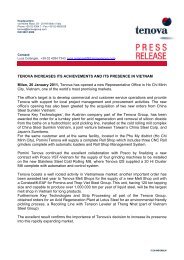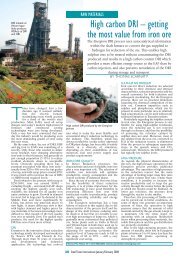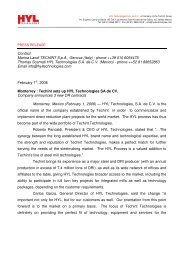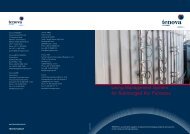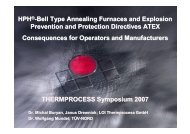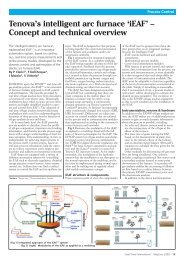Developments Toward an Intelligent Electric Arc Furnace at - Tenova
Developments Toward an Intelligent Electric Arc Furnace at - Tenova
Developments Toward an Intelligent Electric Arc Furnace at - Tenova
Create successful ePaper yourself
Turn your PDF publications into a flip-book with our unique Google optimized e-Paper software.
CONCLUSIONS<br />
The furnace perform<strong>an</strong>ce <strong>at</strong> CMC Texas, during the EFSOP ® evalu<strong>at</strong>ion period (February 20 th to march 19 th , 2006) compared to<br />
J<strong>an</strong>uary 2006 is summarized in Table 1. The reduction in the power on time <strong>an</strong>d the electrical energy consumption <strong>an</strong>d the increase in<br />
yield in particular resulted in <strong>an</strong> overall saving of 3.02 dollars per cast ton.<br />
Table 1: EFSOP ® Perform<strong>an</strong>ce Summary based on cast short tons.<br />
Perform<strong>an</strong>ce<br />
Parameters<br />
Baseline<br />
EFSOP ®<br />
Optimiz<strong>at</strong>ion<br />
Difference<br />
Power on time (min.) 37.94 37.45 0.49<br />
Savings<br />
<strong>Electric</strong>ity, Kwh/t 376.75 367.52 9.23 $ 0.40<br />
Gas, scf/t 236.98 227.83 9.15 $ 0.10<br />
Carbon, lb/t 28.21 30.57 -2.36 - $ 0.22<br />
Oxygen, scf/t 1131.88 1124.00 7.87 $ 0.02<br />
Yield, % 91.83 92.33 0.5 $ 1.25<br />
Productivity<br />
Cast ton/POT<br />
Overall perform<strong>an</strong>ce,<br />
$/ cast ton<br />
($/t)<br />
3.19 (t/min) 3.22 (t/min) 0.03 (t/min) $ 0.66<br />
M<strong>an</strong>y of the steel-making parameters in the EAF, due to limit<strong>at</strong>ions in sensor technology, are measured sporadically <strong>an</strong>d possibly only<br />
once or twice per he<strong>at</strong>. For example, b<strong>at</strong>h carbon <strong>an</strong>d temper<strong>at</strong>ure may be sampled once or twice per he<strong>at</strong> or sometimes not <strong>at</strong> all; slag<br />
<strong>an</strong>d b<strong>at</strong>h residuals are sampled only once (if <strong>at</strong> all) <strong>an</strong>d <strong>an</strong>alysis is done off-line. Very little dynamic inform<strong>at</strong>ion exists for the steelmaker<br />
to gauge the progress of the process from start to finish. The adv<strong>an</strong>tage provided to steel-makers by the EFSOP ® system is a<br />
dynamic measure of chemical energy usage over the course of the he<strong>at</strong> <strong>an</strong>d the corresponding link to the process. The goal of the<br />
modeling effort explained above is to provide a tool th<strong>at</strong> rel<strong>at</strong>es dynamic off-gas measurements to import<strong>an</strong>t steel-making<br />
consider<strong>at</strong>ions <strong>an</strong>d the oper<strong>at</strong>ion of the furnace in general. The following modules are being developed to extend the capabilities of<br />
the Goodfellow EFSOP ® system.<br />
Enh<strong>an</strong>ced w<strong>at</strong>er-leak detection: Above was described <strong>an</strong> empirical method determining the possible incidence of w<strong>at</strong>er-leaks in the<br />
EAF. The gas-phase model, through a hydrogen bal<strong>an</strong>ce is able to calcul<strong>at</strong>e w<strong>at</strong>er in-leakage into the EAF directly. Some tuning will<br />
still be necessary to account for wet scrap, flashing of oils, etc. but it is expected th<strong>at</strong> the method will be more accur<strong>at</strong>e th<strong>an</strong> the<br />
empirical approach presented.<br />
Cost-based post combustion: Presently, the control of post-combustion in the EAF is done through post-combustion r<strong>at</strong>ios or other<br />
similar measures of the extent of combustion in a fee-back loop to oxygen <strong>an</strong>d meth<strong>an</strong>e r<strong>at</strong>es. These simple methods do not take into<br />
account the fact th<strong>at</strong> the efficiency of post-combustion varies over the course of the he<strong>at</strong>. To account for this, constraints on the<br />
maximum <strong>an</strong>d minimum allowable r<strong>at</strong>es of oxygen <strong>an</strong>d meth<strong>an</strong>e are varied over the course of the he<strong>at</strong>. For example, if postcombustion<br />
is deemed inefficient, then the maximum allowable oxygen r<strong>at</strong>e is set lower to minimize oxygen usage during th<strong>at</strong><br />
particular interval.<br />
The mass/energy model may be used to estim<strong>at</strong>e the efficiency of combustion within the EAF directly. This parameter, in turn, along<br />
with costs for oxygen, meth<strong>an</strong>e <strong>an</strong>d energy may be used to calcul<strong>at</strong>e the marginal benefit per unit of oxygen or meth<strong>an</strong>e. Feedback to<br />
the burners c<strong>an</strong> then be based on the cost/benefit of oxygen or meth<strong>an</strong>e usage accordingly.<br />
Fume system control: In m<strong>an</strong>y EAF shops, the thre<strong>at</strong> of explosions within the de-dusting system <strong>an</strong>d other safety concerns have<br />
resulted in over-drafting of the EAF. A larger th<strong>an</strong> necessary ballast of air entering the EAF takes with it valuable energy <strong>an</strong>d<br />
represents a considerable in-efficiency in the oper<strong>at</strong>ion of the EAF. A dynamic measure of off-gas composition, along with a<br />
mass/energy bal<strong>an</strong>ce makes it possible to calcul<strong>at</strong>e the amount of in-leakage air <strong>an</strong>d the he<strong>at</strong>-load on the EAF fume system. This<br />
inform<strong>at</strong>ion may be used to minimize (within safety constraints) the amount of air-in leakage into the EAF.<br />
$ 2.21




